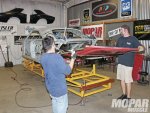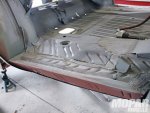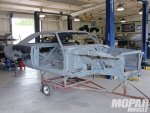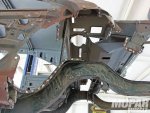clinto
Moderator, wonderful human being & practicing Deuc
Staff member
Administrator
Super Moderator
Steel Soldiers Supporter
Supporting Vendor
- 12,609
- 1,164
- 113
- Location
- Athens, Ga.
So in reality, there are 3 kinds of shops that will touch this:
A. The redneck losers NDT mentioned. They'll (maybe) grind the rust away and fill the holes with bondo or all metal. Your paint job will self destruct within 6-12 months as all the rust they didn't fix will resurface.
B. The mid-grade shop. They will tell you to put rocker panels, partial floors, a new roof and probably some other stuff, because once you get into that thing, you're going to find a lot more corrosion.
C. The right kind of shop: The shop that has people who know what they're doing and care about their reputation will take one look at that body and tell you what I am going to tell you: That it's rusting away from the inside and the only way to stop it would be either to acid dip it or cut it apart so that you can sandblast the inside sections of the body.
Like this:







The pictures above came from this article and looking through it, I'd easily say this is $10K worth of work, probably more.
http://www.hotrod.com/cars/project-vehicles/1309-1969-dodge-charger-project-50-introduction/
I only have experience with "C" shops and it isn't cheap.

I have a friend who owns a shop like this: All they do is metalwork on high end classics-Plymouth Superbirds, Mercedes Gullwings, etc. They got a '70 440-6pack, 4speed, Dana60, Shaker hood Challenger a couple years ago. It was a numbers matching complete car with build sheets and everything, but a northern rustbucket. Frame rails, roof, cowl, floors, all gone. They mounted it to a frame bench and they have all the specs for the Chrysler E-body, they surgically removed (by drilling out the spot welds) all the sheetmetal that was bad and when they got down to where something was usable, they blasted it, then remounted it to the bench and put it back together like the factory would have, only better (I could tell you a lot about the factory bodies are out of spec, and get worse as you move up).
The car came to them pretty much diassembled. It was a $22K job. All they did was sheetmetal. No paint or primer. From them, it went to the paint shop.
Here's the problem: When the factories welded together the bodies of '69 Chargers and '85 Blazers, it was all bare, unpainted, sheetmetal. They welded it up and then dipped it in a solution that was supposed to help keep it from rusting. I don't know about GM but Chrysler didn't even dip the entire body-when you cut the body parts off a Mopar, you can see the dip line:


Even if GM dipped your Blazer all the way to the top (total submersion), you should remember something: All they were after was the body not to rust out before it got out of warranty.
So all that bare metal sheetmetal (and the aforementioned dip was nearly useless, take it from me) is just rusting away, from the very first night that the vehicle sat outside and dew formed.
So the entire inside of the roof looks like the picture you took of the hole. It just hasn't rusted all the way out. Go take a small flashlight and look inside.
Same with the rockers. Everything that you can't see looks like that.
So unless you want to literally take the body apart, sandblast it and then weld it back together (after properly treating it of course), then you can patch all that stuff and 6-12 months later, the corrosion will bubble through 6" from where you did all that work to patch it.
And I know what a lot of people are thinking: "Well Clint, this isn't a quarter million dollar Hemi 'Cuda, it isn't worth doing all that work". Well, I can't deny that but the reality is that the rust doesn't care what the dollar value is of the metal it's attacking. It wants to eat sheetmetal and it doesn't care if it's a Ferrari 250GTO or an old Chevy Blazer.
So if you want to resurrect that Blazer, I'd take a bit to decide what you want and what you're prepared for.
If I was really hung up on that particular model, I'd spend the money and buy a body from the deserts of Arizona New Mexico, etc. and swap the body. If that is undoable for whatever reason, then buy a collection of drill bits designed to drill through spot welds and start taking the body apart and fix it the right way, once. There will be a lot of drilling, a lot of sandblasting, a lot of paint and primer and sealer and a lot of welding/bending/fabricating.
If that's not worth it, buy another one with a better body and make one good truck out of the two.
A. The redneck losers NDT mentioned. They'll (maybe) grind the rust away and fill the holes with bondo or all metal. Your paint job will self destruct within 6-12 months as all the rust they didn't fix will resurface.
B. The mid-grade shop. They will tell you to put rocker panels, partial floors, a new roof and probably some other stuff, because once you get into that thing, you're going to find a lot more corrosion.
C. The right kind of shop: The shop that has people who know what they're doing and care about their reputation will take one look at that body and tell you what I am going to tell you: That it's rusting away from the inside and the only way to stop it would be either to acid dip it or cut it apart so that you can sandblast the inside sections of the body.
Like this:







The pictures above came from this article and looking through it, I'd easily say this is $10K worth of work, probably more.
http://www.hotrod.com/cars/project-vehicles/1309-1969-dodge-charger-project-50-introduction/
I only have experience with "C" shops and it isn't cheap.

I have a friend who owns a shop like this: All they do is metalwork on high end classics-Plymouth Superbirds, Mercedes Gullwings, etc. They got a '70 440-6pack, 4speed, Dana60, Shaker hood Challenger a couple years ago. It was a numbers matching complete car with build sheets and everything, but a northern rustbucket. Frame rails, roof, cowl, floors, all gone. They mounted it to a frame bench and they have all the specs for the Chrysler E-body, they surgically removed (by drilling out the spot welds) all the sheetmetal that was bad and when they got down to where something was usable, they blasted it, then remounted it to the bench and put it back together like the factory would have, only better (I could tell you a lot about the factory bodies are out of spec, and get worse as you move up).
The car came to them pretty much diassembled. It was a $22K job. All they did was sheetmetal. No paint or primer. From them, it went to the paint shop.
Here's the problem: When the factories welded together the bodies of '69 Chargers and '85 Blazers, it was all bare, unpainted, sheetmetal. They welded it up and then dipped it in a solution that was supposed to help keep it from rusting. I don't know about GM but Chrysler didn't even dip the entire body-when you cut the body parts off a Mopar, you can see the dip line:


Even if GM dipped your Blazer all the way to the top (total submersion), you should remember something: All they were after was the body not to rust out before it got out of warranty.
So all that bare metal sheetmetal (and the aforementioned dip was nearly useless, take it from me) is just rusting away, from the very first night that the vehicle sat outside and dew formed.
So the entire inside of the roof looks like the picture you took of the hole. It just hasn't rusted all the way out. Go take a small flashlight and look inside.
Same with the rockers. Everything that you can't see looks like that.
So unless you want to literally take the body apart, sandblast it and then weld it back together (after properly treating it of course), then you can patch all that stuff and 6-12 months later, the corrosion will bubble through 6" from where you did all that work to patch it.
And I know what a lot of people are thinking: "Well Clint, this isn't a quarter million dollar Hemi 'Cuda, it isn't worth doing all that work". Well, I can't deny that but the reality is that the rust doesn't care what the dollar value is of the metal it's attacking. It wants to eat sheetmetal and it doesn't care if it's a Ferrari 250GTO or an old Chevy Blazer.
So if you want to resurrect that Blazer, I'd take a bit to decide what you want and what you're prepared for.
If I was really hung up on that particular model, I'd spend the money and buy a body from the deserts of Arizona New Mexico, etc. and swap the body. If that is undoable for whatever reason, then buy a collection of drill bits designed to drill through spot welds and start taking the body apart and fix it the right way, once. There will be a lot of drilling, a lot of sandblasting, a lot of paint and primer and sealer and a lot of welding/bending/fabricating.
If that's not worth it, buy another one with a better body and make one good truck out of the two.


